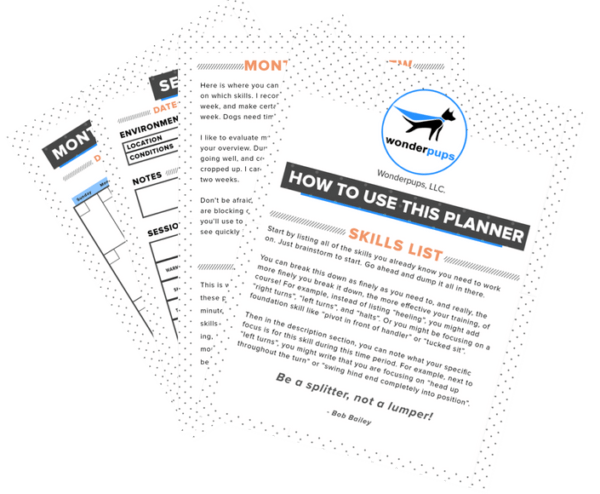Since Rugby finished his CDSP Novice title this spring, we’ve been working on prepping to compete in Open later this summer (or fall, we’ll see how I feel. I don’t want to commit officially yet). His Drop on Recall has been solid (and pretty damn fancy, if you ask me) for a while now, broad jump is looking good, and I’m very happy with where his retrieve is at this point. So the weakest link right now is the go out. In CDSP Open, there is a 25ft Go Out, turn and sit. So it’s certainly easier than the Utility-style Directed Jumping exercise, but not nothing either.
I teach this exercise as a targeting behavior. Teaching the dog to touch (with nose or paw) a target, first on the ground, and then transferring that behavior to a ring stanchion (the upright portion of the ring gates).
Rugby has been paw targeting the stanchion beautifully, we’ve added distance, and now I’m circling back to very short distance and working on generalization and adding distractions.
A lot of folks worry about sending the dog on a go out that ends in a blank wall (when the exercise was taught with a target). But in my personal experience, my own dogs have generalized to blank wall really quickly. Like in the first session.
What has consistently challenged them though, is the opposite… TOO many possible targets at the far end of the ring.
I’ve noticed my dogs struggling on the go out especially when the background behind the gates is very busy. Either multiple rings that overlap, or chairs, crates or bleachers just on the other side of the gates. And any kind of vertical object or line is especially problematic, like a structural beam or door frame just to one side of the center stanchion (the one they should be targeting).
The struggle will manifest as either an incorrect performance (the dog goes out, but ends up off center or even directly targets the wrong spot) or in avoidance, displacement, and confusion (slowing down, incomplete performance, or even non-response). Too many similar targets create a discrimination problem, and the dog has to choose.
Having suffered through learning the hard way with previous dogs, I wanted to make sure to incorporate this challenge into Rugby’s training… especially since his distance behaviors in general, and go outs in particular, are kinda fragile.
So I wanted to add a simple vertical distraction to (what I believed to be) a familiar setup. My plan was to create a picture that showed him a very easy version of this distraction. He already had a massive reinforcement history for touching the stanchion in this exact setting (my own yard, same direction, and placement as previous sessions) and I would just insert the distraction off to the side to make for a very easy choice, and he can collect reinforcement history for the correct response.
I grabbed a step-in plastic fence post and stuck it in the ground several feet from the stanchion.
And I learned something!
When the post was to the left of the stanchion (my left), Rugby had no problem whatsoever. When it was to the right of the stanchion, total brainsplosion. He ran right out to the gate, stood in front of the post, and froze with a look that can only be described as “huh?” (I know, anthropomorphic again).
So I decreased the distance from me to the stanchion and tried again, and he was able to get the behavior successfully, so we quit before I dug my hole any deeper.
And then I grabbed Gambit, who has much more experience with go out pictures, but also much more baggage from less-than-ideal training decisions in the past. And sure enough, he ran straight to the fence post, realized he was wrong and started showing stress and displacement behaviors (turning away, snifffing, etc). Nice job, trainer. Real nice.
Again, shortened the distance (by a lot), which I should have done in the first place. Got a few correct responses to reinforce, and ended with a nice play session to hopefully take the sting off my error.
Then brought my baby girl, Spark, out. I started quite close and then increased distance. And she nailed it! One glance at the fence post, and then zeroed right in on the stanchion. Not one mistake. And THAT is how a good training session ought to go.
It could be that Spark is especially brilliant (which she is), or it could be that it takes me screwing up twice before I get it right finally the third time.
Thank heavens dogs are so forgiving.
